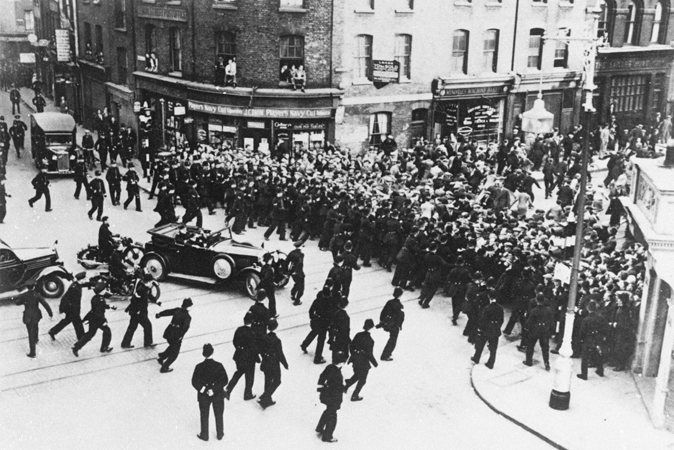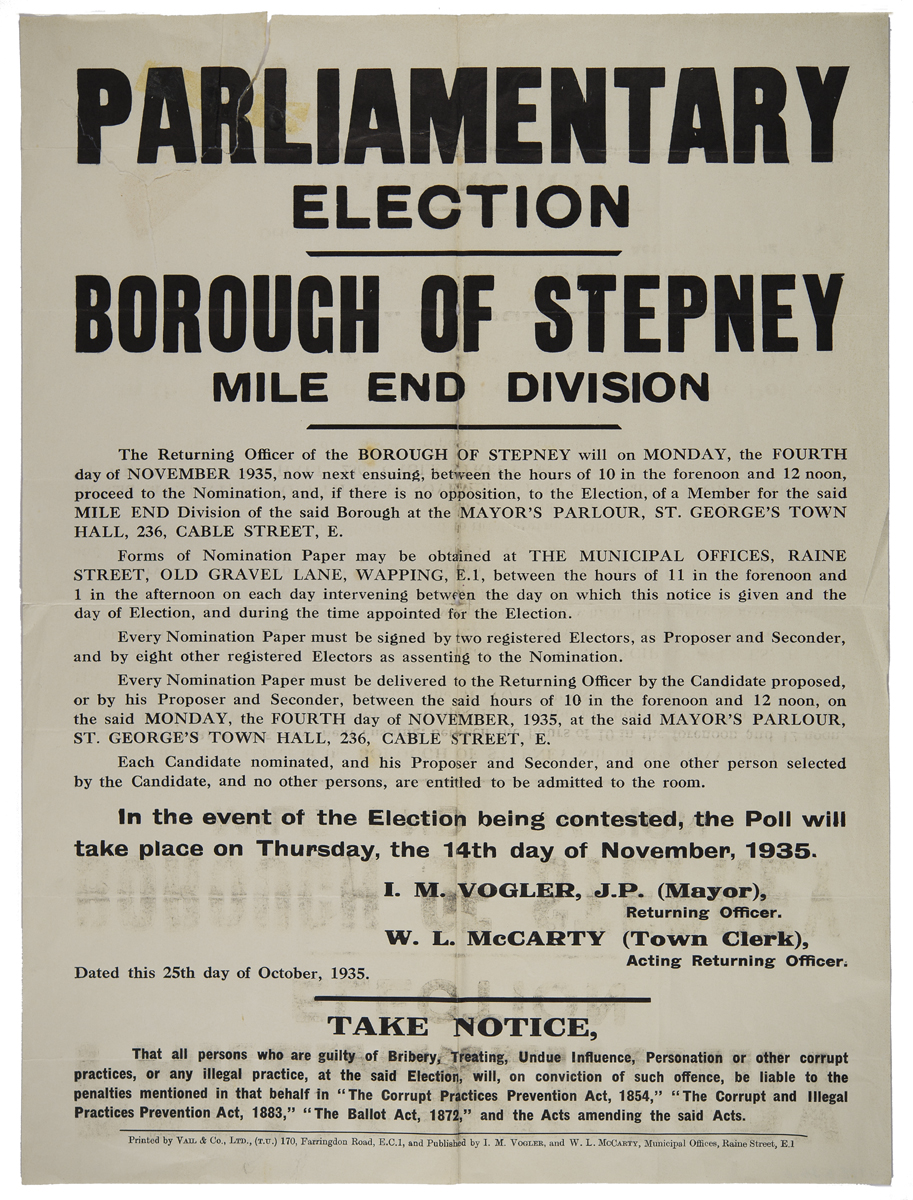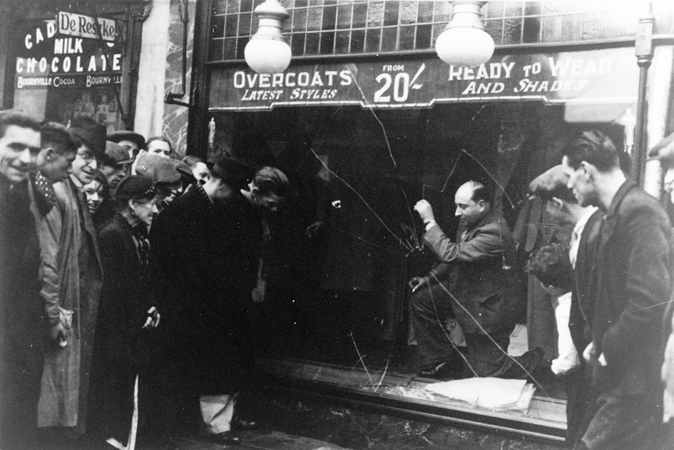Councillors, Communists and Cockneys
 1196.1 - Battle of Cable Street
1196.1 - Battle of Cable StreetLike so many arriving through the doors of the Jewish Museum London, I came with questions about family. I came to my collections placement with the aim of finding some evidence of a connection between my relatives and any objects at the museum. Something to bridge the gap between family legend and historical fact. Ideally, this would lead to some evidence of my grandmother’s family within the broader Jewish community in London.
The only historical records preserved within the family were my grandfather’s family’s lightermen licenses. We knew that my great-grandfather, Charles ‘Todd’ Carver, had been a prominent trade unionist in the East London dockworkers as a lighterman. This profession had been passed in the family for five generations, as the rights of the river did. However, it was rumoured, somewhat infamously, that his brother had been a communist. We had this leaflet ‘A Stepney To Be Proud Of’ which was the Communist Party’s proposals for the regeneration of Stepney somewhere around WWII. This detailed several local figures of the party with some political footing. This includes my relative, Horace William ‘Bill’ Carver who is described as a MP on Stepney Borough Council.

Fig. 1 – 1988.434.6. Parliamentary Election Poster for Stepney, 1935
Consequently, I targeted Stepney Borough Council within the museum collections. Some enquiries where fruitless, for example, a diary for a council member in 1934 or a 1935 Parliamentary Election poster for the Borough of Stepney (Figure 1). Despite excellent examples of local administration it does not list the names I was looking to corroborate. However, the assertions in the Stepney leaflet were supported by a notice for a special meeting brought by Stepney Borough Council on 11th February 1952 (Figure 2). H.W. Carver is named in attendance in the first column. From this, we have a date when Bill was an active member of the Council. Noticeably on the reverse, it notes the absence of councillors, including Councillor Max Levitas, who is also named in the Stepney To Be Proud Of leaflet.

Fig. 2 – 1997.1.3. Metropolitan Borough of Stepney Council minutes, 1952.
In an odd parallel, this notice and the meeting it documented were produced to recognise the death of George VI. In my own timeline, the death of Elizabeth II and coronation of Charles III are still fresh in the news and debate. I wondered what a communist representative such as Bill would have said in these times.
Further named in Stepney leaflet is Michael Shapiro, also known by his pen name Michael Best. It transpires that Shapiro and his wife Aumie were passionate about documenting the East End through its changes and have produced several books that can be found in the Museum’s Reference Library, including ‘Jewish Eastenders’ edited by Aumie and Michael Shapiro (EE41) and ‘The Jewish East End: Then and Now’ edited by Aumie and Michael Shapiro (EE36).
Another prominent figure presented in the leaflet is Phil Piratin, who Bill is described as working for. In the Stepney leaflet, Piratin is a ‘prospective’ parliamentary candidate for Mile End. Piratin was elected as MP for Stepney between 1945-50 but did not make re-election in 1950. We know now that Bill was a sitting MP on Stepney Borough Council in 1952 and is still described as a sitting MP in the Stepney leaflet. We also know that the MP seat for Mile End was abolished in 1950 and became the MP seat for Stepney due to changes to the constituency boundaries for the 1950 election. Therefore, this dates the leaflet to before 1945, from before the election of Piratin in as MP. With Bill named as an local councillor in the Stepney leaflet and in the special meeting notice in 1952, this also suggests he served for multiple terms as a councillor.
Phil Piratin was a leading figure in the London Communist Party (CPGB) as one of the only ever elected communist MP’s.He was also a chief combatant against Oswald Mosley and British Union of Fascists (BUF). The Battle of Cable Street was a series of clashes between the Metropolitan Police, who’d been sent to protect a demonstration by the BUF; and all the groups that opposed them through the streets of the East End on 4th October 1936 (Figure 3). The museum holds transcripts of a selection of figures involved in the Battle of Cable Street, including Piratin, conducted in 1987 where he reflects on the events that occurred, the attitudes on both sides that created them and changes since his political career. He was first elected to Stepney Borough Council in 1937, a year following those clashes. Thus we have a relative, cited as working for a prominent local politician, at a time of significant political unease in a post-war Britain. It connects the individual beliefs of Bill in my family to a much wider grassroots political movement the East End, which was undergoing significant transformation. It is an important demonstration of interconnectivity between Jewish and gentile members of the East End and certainly makes it easier to understand how and why my grandparents later met and married.

Fig. 3 – 1196.2. Aftermath of Battle of Cable Street
So what questions were answered? Overall, very few. More questions have emerged. What this research has revealed is plenty of contextualisation for my grandparents. It sets their lives, their families, our relatives, in the backdrop of a post-war Britain as well as the circumstances of their meeting in the microcosm of London East End in the 1950s. As the last generation to have living connection to WWII through our grandparents, we are often taught about the emergence of the welfare state post WWII. But it feels equally significant to understand the political shifts happening at a grassroots level preceding this. The borough of Stepney may be an uncharacteristic example, but nonetheless, we know now my great grand-uncle worked for Phil Piratin, and the circumstances of the political scene at the time. It begs the question of my relatives’ direct involvement in pivotal moments in the history of the East End, would he have been present at the Battle of Cable Street?
Where to go from here? I’d certainly love to utilise the Museum’s support of the Jewish Genealogical Society of Great Britain and investigate my grandmother’s family as they arrived to the UK. Like many others, names were changed and consequently beyond Woodford Green, not much is known. What is certain, is that the Jewish Museum London provides an invaluable tool for amateur and professional historians in recording the unique slice of life in the East End and the Jewish community.